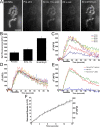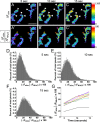Heterogeneity in synaptic vesicle release at neuromuscular synapses of mice expressing synaptopHluorin
- PMID: 18171949
- PMCID: PMC6671144
- DOI: 10.1523/JNEUROSCI.3544-07.2008
Heterogeneity in synaptic vesicle release at neuromuscular synapses of mice expressing synaptopHluorin
Abstract
Mammalian neuromuscular junctions are useful model synapses to study the relationship between synaptic structure and function, although these have rarely been studied together at the same synapses. To do this, we generated transgenic lines of mice in which the thy1.2 promoter drives expression of synaptopHluorin (spH) as a means of optically measuring synaptic vesicle distribution and release. SpH is colocalized with other synaptic vesicle proteins in presynaptic terminals and does not alter normal synaptic function. Nerve stimulation leads to readily detectable and reproducible fluorescence changes in motor axon terminals that vary with stimulus frequency and, when compared with electrophysiological recordings, are reliable indicators of neurotransmitter release. Measurements of fluorescence intensity changes reveal a surprising amount of heterogeneity in synaptic vesicle release throughout individual presynaptic motor axon terminals. Some discrete terminal regions consistently displayed a greater rate and extent of release than others, regardless of stimulation frequency. The amount of release at a particular site is highly correlated to the relative abundance of synaptic vesicles there, indicating that a relatively constant fraction of the total vesicular pool, approximately 30%, is released in response to activity. These studies reveal previously unknown relationships between synaptic structure and function at mammalian neuromuscular junctions and demonstrate the usefulness of spH expressing mice as a tool for studying neuromuscular synapses in adults, as well as during development and diseases that affect neuromuscular synaptic function.
Figures








Similar articles
-
Monitoring synaptic function at the neuromuscular junction of a mouse expressing synaptopHluorin.J Neurosci. 2007 May 16;27(20):5422-30. doi: 10.1523/JNEUROSCI.0670-07.2007. J Neurosci. 2007. PMID: 17507564 Free PMC article.
-
Synaptic vesicle distribution and release at rat diaphragm neuromuscular junctions.J Neurophysiol. 2007 Jul;98(1):478-87. doi: 10.1152/jn.00251.2006. Epub 2007 May 9. J Neurophysiol. 2007. PMID: 17493926
-
Motorneurons require cysteine string protein-α to maintain the readily releasable vesicular pool and synaptic vesicle recycling.Neuron. 2012 Apr 12;74(1):151-65. doi: 10.1016/j.neuron.2012.02.019. Neuron. 2012. PMID: 22500637
-
Synaptic Vesicles Having Large Contact Areas with the Presynaptic Membrane are Preferentially Hemifused at Active Zones of Frog Neuromuscular Junctions Fixed during Synaptic Activity.Int J Mol Sci. 2019 May 31;20(11):2692. doi: 10.3390/ijms20112692. Int J Mol Sci. 2019. PMID: 31159267 Free PMC article. Review.
-
Mammalian neuromuscular junctions: modern tools to monitor synaptic form and function.Curr Opin Pharmacol. 2009 Jun;9(3):297-305. doi: 10.1016/j.coph.2009.03.006. Epub 2009 Apr 23. Curr Opin Pharmacol. 2009. PMID: 19394273 Review.
Cited by
-
Molecular mechanism of active zone organization at vertebrate neuromuscular junctions.Mol Neurobiol. 2012 Feb;45(1):1-16. doi: 10.1007/s12035-011-8216-y. Epub 2011 Dec 2. Mol Neurobiol. 2012. PMID: 22135013 Free PMC article. Review.
-
Evaluation of a novel calcium channel agonist for therapeutic potential in Lambert-Eaton myasthenic syndrome.J Neurosci. 2013 Jun 19;33(25):10559-67. doi: 10.1523/JNEUROSCI.4629-12.2013. J Neurosci. 2013. PMID: 23785168 Free PMC article.
-
Impact of spatiotemporal calcium dynamics within presynaptic active zones on synaptic delay at the frog neuromuscular junction.J Neurophysiol. 2018 Feb 1;119(2):688-699. doi: 10.1152/jn.00510.2017. Epub 2017 Nov 22. J Neurophysiol. 2018. PMID: 29167324 Free PMC article.
-
Organization and function of transmitter release sites at the neuromuscular junction.J Physiol. 2013 Jul 1;591(13):3159-65. doi: 10.1113/jphysiol.2012.248625. Epub 2013 Apr 22. J Physiol. 2013. PMID: 23613535 Free PMC article. Review.
-
Synaptic vesicle pools and dynamics.Cold Spring Harb Perspect Biol. 2012 Aug 1;4(8):a013680. doi: 10.1101/cshperspect.a013680. Cold Spring Harb Perspect Biol. 2012. PMID: 22745285 Free PMC article. Review.
References
-
- Betz WJ, Bewick GS. Optical analysis of synaptic vesicle recycling at the frog neuromuscular junction. Science. 1992;255:200–203. - PubMed
-
- Caroni P. Overexpression of growth-associated proteins in the neurons of adult transgenic mice. J Neurosci Methods. 1997;71:3–9. - PubMed
-
- Delgado R, Maureira C, Oliva C, Kidokoro Y, Labarca P. Size of vesicle pools, rates of mobilization, and recycling at neuromuscular synapses of a Drosophila mutant, shibire. Neuron. 2000;28:941–953. - PubMed
Publication types
MeSH terms
Substances
Grants and funding
LinkOut - more resources
Full Text Sources
Molecular Biology Databases
Miscellaneous
